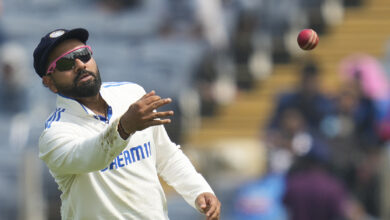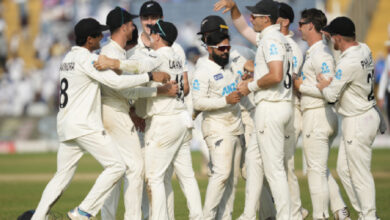IND vs NZ: As Jadeja-Ashwin endure rare below-par home series, India’s overdependence on their matchwinners is ever so clear | Cricket News

Ravindra Jadeja hoicked the ball and watched in agony as Tim Southee swallowed the catch to wrap up a famous victory for New Zealand. He turned around and paused, before Jasprit Bumrah consoled him. Shortly, the victors offered him commiseration. But nothing seemed to reger in his mind, as he trudged back. Near the sight screen, the other half of India’s most successful pair, Ravichandran Ashwin, waited for him and wrapped his arms around his shoulder. It was a symbolic moment—in pain and praise, the greatest Indian double act was together.
Jadeja and Ashwin, along with Virat Kohli, are the only ones in the current squad to have experienced the pain of losing a Test series at home. All three were on the foothills of their career – Jadeja was a debutant in Nagpur against England in 2012 – and were touted as the future of Indian cricket, when another generation slipped into the sunset. Twelve years later, they are in a similar zone as their predecessors, the prime past them but the light not yet out of them. The craft has not fully diminished, but they could feel the shoulders rebelling, their fingers crying, even though the spirit is raging.
The remorseless destroyers of foreign batsmen endured a rare poor series. Between them, they tallied just 12 wickets in four innings, were out-bowled the visiting spinners as well as sidekick Washington Sundar.
It could be an exception — a combination of end-of-the-year fatigue and Kiwi batsmen defying them surgically. It could be that when you age — Ashwin is 38 and Jadeja would turn 36 in a month—the bad days turn up more frequently. For much of his career, not a series passed without Sachin Tendulkar scoring a hundred. But towards the end, it began to recur more before it dried up altogether. How long he waited for his century of centuries.
Same with the five-fors of Ashwin and Jadeja. Rarely has a series passed without it. But it instructed how dependent, even over-dependent, India had been on them in building their intimidating home empire. It’s not happenstance that their first fallow series ended in a series defeat.
This series, Jadeja’s fabled control deserted him, the fizz he coaxed off the surface evaded him. Uncharacterically, he erred too often on the fuller or shorter side. He conceded 3.44 runs an over this series, as opposed to 2.49 in his overall career. Similarly, Ashwin atypically struggled to locate the precise pace or length to bowl on the wickets. The sweeps and reverse-sweeps of New Zealand batsmen disrupted him. Fortune did not smile at him, but he was culpable of getting into a reactive mood, where generally he is proactive.
It could be that when you age — Ashwin is 38 and Jadeja would turn 36 in a month—the bad days turn up more frequently. (PTI Photo)
There had been times when one of them had looked off-colour, but seldom together. That they together managed only seven maiden overs across both innings reflected their lack of control on a helpful track.
Later, captain Rohit Sharma dwelled on why Santner was more successful than Ashwin and Jadeja. ”He kept the ball on the stumps and that is where the challenge happens. When you pitch it on the stumps, you don’t know which one is going away, which one is keeping straight. We had to exploit this a lot more and make them play as many balls as possible,” Sharma pointed out.
But he also sympathised with them. “ their standard, they know where they stand and what they haven’t been able to do or what they have done really well. But again, both of them have played so much cricket here and have such huge contributions to our success of having that home streak of 18 series,” he said.
The soul of India’s turner-fixation was the stability of Jadeja and Ashwin, the unshakeable reality that if Ashwin doesn’t get you, Jadeja would. Their guarantee was safer than the vaults of any locker. The burgeoning fast-bowling stock sometimes stole the thunder. As menacing as the new wave of pacers was, India’s identity at home was Ashwin and Jadeja.
Between the two home series defeats, Jadeja nabbed 225 wickets at an average of 20.85. Ashwin grabbed 326 at 20.47. They seemed immune to the fickleness of form. Not a series had passed without them producing a match-winning spell, sometimes tangoing, sometimes alone. Whenever India were in jeopardy, they produced defining feats. As pure spinners, without even weighing their contributions with the bat. They are an unrepeatable pair, but the series was a reminder that India should be prepared for a time without them.
Their days are far from over. It’s not yet the time to talk about phasing them out. But the moment, though, has arrived to chalk up the succession plan, to ensure that they are not overburdened with both workload and wicket-taking expectations. It’s time to share the labour with others like Kuldeep Yadav, Axar Patel and Washington Sundar and form the second line. Maybe to even preserve them for only significant matches. So that their indispensable departure would not feel sudden, or the transition turn jerky. As Rohit said, “The youngsters should take more responsibility and come up with match-winning opportunities.”
For that they should not only blood more youngsters but also ensure that they are groomed and grooved to inherit the mantle when they bid farewell. A lesson could be gleaned from how MS Dhoni dispensed more duties on a young Ashwin when Harbhajan began to show signs of decline.
An inverse lesson could be learned from England too. After James Anderson unhyphenated from Stuart Broad, their successors fell apart., They came undercooked, unable to handle the rigours of Test cricket. Inheritances are messy affairs, and it would not harm Indian cricket to chart out succession plans. Even if it is for the greatest match-winners of this era.







